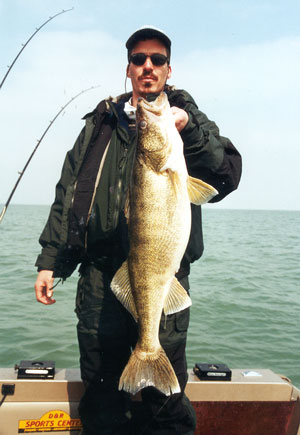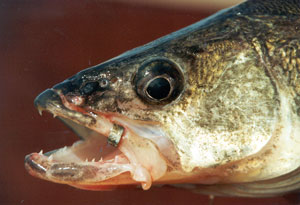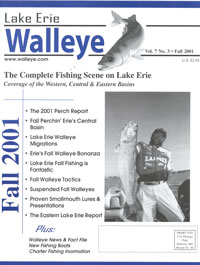he inline planer board surged rearward signaling a
sizeable fish on the business end. After a five-minute fight, I slipped the net
under a thrashing, chunky six pounder. While I unhooked her, I noticed a dull,
metal tag protruding from that tooth-lined mouth. On my charter boat, itís
policy to release all pre-spawn female walleyes along with any tagged fish:
Unless of course they are of trophy proportions and are headed for the
taxidermist. Using needle nosed pliers, I rotated the tag around and wrote down
the tag information in my fishing log. I also recorded the time, date, weight,
length and capture  coordinates
in my log. We then released the fish so further study would be possible on the
fish. Later that month, I collected all the tag data from April captures and
sent it to the Michigan DNR. A few weeks later and I received a letter thanking
me for my assistance. The letter also contained information on each fish. The
six-pounder had been tagged two years earlier near Monroe, MI., less than a mile
from where I caught her. In just two years that fish had nearly doubled its body
weight and had grown six inches longer. Since we released that fish, it is now
possible for someone else to catch it and provide additional growth and
migration data for the study. Who knows, maybe some day sheíll show up in my
landing net again weighing over 10-pounds. Ah, wishful thinking.
coordinates
in my log. We then released the fish so further study would be possible on the
fish. Later that month, I collected all the tag data from April captures and
sent it to the Michigan DNR. A few weeks later and I received a letter thanking
me for my assistance. The letter also contained information on each fish. The
six-pounder had been tagged two years earlier near Monroe, MI., less than a mile
from where I caught her. In just two years that fish had nearly doubled its body
weight and had grown six inches longer. Since we released that fish, it is now
possible for someone else to catch it and provide additional growth and
migration data for the study. Who knows, maybe some day sheíll show up in my
landing net again weighing over 10-pounds. Ah, wishful thinking.
Biologists and anglers from Ohio, Michigan, New York and Ontario, have been
conducting interagency research on Lake Erieís walleye movements and
migrations. The studies have shown that Erieís walleyes are highly nomadic,
however they do posses homing instincts that consistently brings them back to
the same spots year after year for spawning. The migration studies key on that
homing instinct. Walleyes are captured using nets and boom shockers in the
spawning areas where unique lip tags are attaching to the fish. After spawning,
the walleyes disburse out. Eventually, some of those tagged fish are caught and
the information is reported back. These returns continue to reveal some
interesting and important scientific information on migration patterns. These
studies directly help fisheries professionals manage our walleye resources and
they also help anglers to key in on the best places to fish during the different
seasons.
Bob Haas is a Fisheries Biologist overseeing the Lake Erie tagging studies
for the Michigan DNR. Haas says, "During the spring, more than 80% of Lake
Erieís walleyes end up in the Western Basin and its tributaries. The Michigan
DNR has been setting trap nets as part of a tagging study since 1978. We have
historically netted walleyes just south of Monroe along a spawning reef. Our
goal has been to tag 2,000 walleyes each year during the April spawning period.
Most years weíve been very successful."
Haas went on to say, "On average, anglers catch and report 4 to 5
percent of the walleyes that are tagged. Even though Canadian commercial fishers
account for the vast majority of the walleye harvest from Lake Erie, sport
fishermen still account for the lionís share of tag returns. In fact, netters
rarely report any." Haas commends those cooperative anglers that have
participated in this important research throughout the Great Lakes. He recommends that anglers should simply record the information from the tag
without removing it. After recording the tag information, ideally the fish
should be released so further studies on that fish are possible. Haas does
concede though that
recommends that anglers should simply record the information from the tag
without removing it. After recording the tag information, ideally the fish
should be released so further studies on that fish are possible. Haas does
concede though that
tagged walleyes may legally be kept.
The recorded tag information or the physical tag can be dropped off or mailed
to any participating stateís (Ministry in Canada) Natural Resources field
office. Make sure to include the exact location where the walleye was caught.
Also, please list the date and time of the capture along with the length and
weight of the fish if possible. People can also log onto the Michigan DNR
website (http://www.dnr.state.mi.us) and enter the tag information online. The
Michigan DNR will pass the information along to other state or provincial
agencies as applicable. If the cooperator provides his or her name and address,
some history on the fish will be provided. Iíve caught and reported over
100-tagged fish to the DNR and I get a kick out of seeing the bio on those fish.
The Lake Erie migration study is revealing some interesting information to
say the very least. Most of Erieís walleyes are tagged in the Western Basin,
which should come as no surprise since the majority of Erieís walleyes spawn
at Western Basin reefs and rivers. Itís also no surprise that most of the
tagged fish are caught from the Western Basin, which accounts for most of the
sport fishing harvest on Erie. Only about five percent of tagged returns  come
from the Eastern and Central Basins combined. However when the percentage of the
tagged returns are factored against the total catch from each Basin, statistics
show that Lake Erieís adult walleyes spread out rather evenly all over the
system after spawning.
come
from the Eastern and Central Basins combined. However when the percentage of the
tagged returns are factored against the total catch from each Basin, statistics
show that Lake Erieís adult walleyes spread out rather evenly all over the
system after spawning.
Bob Haas says, "The tagging studies have shown that after spawning in
the Western Basin, most adult walleyes migrate east in a circular pattern. They
move eastward along the northern half of Lake Erie during the spring and summer.
During the fall and winter, those same walleyes make their way back
"home" heading west along the southern region of the lake."
A good number of Erieís tagged walleyes are taken from rivers feeding the
Western Basin, especially the Maumee and Detroit Rivers. Surprisingly, a good
number of Lake Erieís walleyes end up in Lake St. Clair and the St. Clair
River and they donít stop there either. Many of Erieís Walleyes are caught
all along the Michigan waters of Lake Huron especially in outer Saginaw Bay.
Some have even shown up at Thunder Bay near Alpena and still farther north all
the way to the Mackinac Bridge. Research has also shown that as walleyes grow
older, they tend to migrate farther. Itís interesting to note that walleyes
tagged in the Saginaw Bay watershed rarely ever disburse to Lake Erie.
Because Erieís walleyes pay no attention to boundaries, the significance of
interagency cooperation is especially important pertaining to the management of
the valuable resource. Researchers are taking the next step with radio telemetry
studies of Great Lakeís walleyes. These and other important projects will help
biologists further unravel walleye travel secrets. Walleyes are perhaps the most
valuable resource swimming in the Great Lakes; they are certainly the most
popular game fish on Lake Erie. Developing a thorough understanding of walleye
migrations is critical for the continued prosperity of our Lake Erie walleye
fishery.

 coordinates
in my log. We then released the fish so further study would be possible on the
fish. Later that month, I collected all the tag data from April captures and
sent it to the Michigan DNR. A few weeks later and I received a letter thanking
me for my assistance. The letter also contained information on each fish. The
six-pounder had been tagged two years earlier near Monroe, MI., less than a mile
from where I caught her. In just two years that fish had nearly doubled its body
weight and had grown six inches longer. Since we released that fish, it is now
possible for someone else to catch it and provide additional growth and
migration data for the study. Who knows, maybe some day sheíll show up in my
landing net again weighing over 10-pounds. Ah, wishful thinking.
coordinates
in my log. We then released the fish so further study would be possible on the
fish. Later that month, I collected all the tag data from April captures and
sent it to the Michigan DNR. A few weeks later and I received a letter thanking
me for my assistance. The letter also contained information on each fish. The
six-pounder had been tagged two years earlier near Monroe, MI., less than a mile
from where I caught her. In just two years that fish had nearly doubled its body
weight and had grown six inches longer. Since we released that fish, it is now
possible for someone else to catch it and provide additional growth and
migration data for the study. Who knows, maybe some day sheíll show up in my
landing net again weighing over 10-pounds. Ah, wishful thinking.
 recommends that anglers should simply record the information from the tag
without removing it. After recording the tag information, ideally the fish
should be released so further studies on that fish are possible. Haas does
concede though that
recommends that anglers should simply record the information from the tag
without removing it. After recording the tag information, ideally the fish
should be released so further studies on that fish are possible. Haas does
concede though that come
from the Eastern and Central Basins combined. However when the percentage of the
tagged returns are factored against the total catch from each Basin, statistics
show that Lake Erieís adult walleyes spread out rather evenly all over the
system after spawning.
come
from the Eastern and Central Basins combined. However when the percentage of the
tagged returns are factored against the total catch from each Basin, statistics
show that Lake Erieís adult walleyes spread out rather evenly all over the
system after spawning.